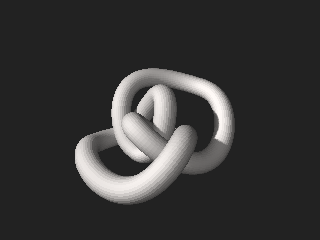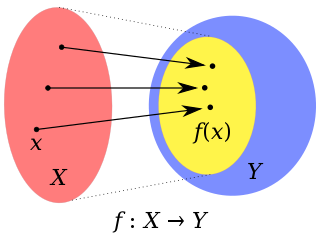Related Research Articles

Complex analysis, traditionally known as the theory of functions of a complex variable, is the branch of mathematical analysis that investigates functions of complex numbers. It is helpful in many branches of mathematics, including algebraic geometry, number theory, analytic combinatorics, and applied mathematics, as well as in physics, including the branches of hydrodynamics, thermodynamics, quantum mechanics, and twistor theory. By extension, use of complex analysis also has applications in engineering fields such as nuclear, aerospace, mechanical and electrical engineering.

In geometry, a subset of a Euclidean space, or more generally an affine space over the reals, is convex if, given any two points in the subset, the subset contains the whole line segment that joins them. Equivalently, a convex set or a convex region is a subset that intersects every line into a single line segment . For example, a solid cube is a convex set, but anything that is hollow or has an indent, for example, a crescent shape, is not convex.

In mathematics, a holomorphic function is a complex-valued function of one or more complex variables that is complex differentiable in a neighbourhood of each point in a domain in complex coordinate space Cn. The existence of a complex derivative in a neighbourhood is a very strong condition: it implies that a holomorphic function is infinitely differentiable and locally equal to its own Taylor series (analytic). Holomorphic functions are the central objects of study in complex analysis.

In complex analysis, the Riemann mapping theorem states that if is a non-empty simply connected open subset of the complex number plane which is not all of , then there exists a biholomorphic mapping from onto the open unit disk
In mathematics, the branch of real analysis studies the behavior of real numbers, sequences and series of real numbers, and real functions. Some particular properties of real-valued sequences and functions that real analysis studies include convergence, limits, continuity, smoothness, differentiability and integrability.

In mathematics, topology is concerned with the properties of a geometric object that are preserved under continuous deformations, such as stretching, twisting, crumpling, and bending; that is, without closing holes, opening holes, tearing, gluing, or passing through itself.

In mathematics, the domain of a function is the set of inputs accepted by the function. It is sometimes denoted by or , where f is the function. In layman's terms, the domain of a function can generally be thought of as "what x can be".

In mathematics, a conformal map is a function that locally preserves angles, but not necessarily lengths.

In mathematics, an analytic function is a function that is locally given by a convergent power series. There exist both real analytic functions and complex analytic functions. Functions of each type are infinitely differentiable, but complex analytic functions exhibit properties that do not generally hold for real analytic functions. A function is analytic if and only if its Taylor series about converges to the function in some neighborhood for every in its domain. It is important to note that it is a neighborhood and not just at some point , since every differentiable function has at least a tangent line at every point, which is its Taylor series of order 1. So just having a polynomial expansion at singular points is not enough, and the Taylor series must also converge to the function on points adjacent to to be considered an analytic function. As a counterexample see the Fabius function.

In the mathematical field of complex analysis, a meromorphic function on an open subset D of the complex plane is a function that is holomorphic on all of Dexcept for a set of isolated points, which are poles of the function. The term comes from the Greek meros, meaning "part".
The theory of functions of several complex variables is the branch of mathematics dealing with functions defined on the complex coordinate space , that is, n-tuples of complex numbers. The name of the field dealing with the properties of these functions is called several complex variables, which the Mathematics Subject Classification has as a top-level heading.
In mathematics, the total variation identifies several slightly different concepts, related to the (local or global) structure of the codomain of a function or a measure. For a real-valued continuous function f, defined on an interval [a, b] ⊂ R, its total variation on the interval of definition is a measure of the one-dimensional arclength of the curve with parametric equation x ↦ f(x), for x ∈ [a, b]. Functions whose total variation is finite are called functions of bounded variation.
In mathematics, with special application to complex analysis, a normal family is a pre-compact subset of the space of continuous functions. Informally, this means that the functions in the family are not widely spread out, but rather stick together in a somewhat "clustered" manner. Note that a compact family of continuous functions is automatically a normal family. Sometimes, if each function in a normal family F satisfies a particular property , then the property also holds for each limit point of the set F.
In mathematics, Carathéodory's theorem is a theorem in complex analysis, named after Constantin Carathéodory, which extends the Riemann mapping theorem. The theorem, first proved in 1913, states that any conformal mapping sending the unit disk to some region in the complex plane bounded by a Jordan curve extends continuously to a homeomorphism from the unit circle onto the Jordan curve. The result is one of Carathéodory's results on prime ends and the boundary behaviour of univalent holomorphic functions.
In mathematics, precisely in the theory of functions of several complex variables, a pluriharmonic function is a real valued function which is locally the real part of a holomorphic function of several complex variables. Sometimes such a function is referred to as n-harmonic function, where n ≥ 2 is the dimension of the complex domain where the function is defined. However, in modern expositions of the theory of functions of several complex variables it is preferred to give an equivalent formulation of the concept, by defining pluriharmonic function a complex valued function whose restriction to every complex line is a harmonic function with respect to the real and imaginary part of the complex line parameter.
In mathematics, more precisely in the theory of functions of several complex variables, a pseudoconvex set is a special type of open set in the n-dimensional complex space Cn. Pseudoconvex sets are important, as they allow for classification of domains of holomorphy.

In the mathematical theory of functions of one or more complex variables, and also in complex algebraic geometry, a biholomorphism or biholomorphic function is a bijective holomorphic function whose inverse is also holomorphic.
In the theory of functions of several complex variables, Hartogs's extension theorem is a statement about the singularities of holomorphic functions of several variables. Informally, it states that the support of the singularities of such functions cannot be compact, therefore the singular set of a function of several complex variables must 'go off to infinity' in some direction. More precisely, it shows that an isolated singularity is always a removable singularity for any analytic function of n > 1 complex variables. A first version of this theorem was proved by Friedrich Hartogs, and as such it is known also as Hartogs's lemma and Hartogs's principle: in earlier Soviet literature, it is also called Osgood–Brown theorem, acknowledging later work by Arthur Barton Brown and William Fogg Osgood. This property of holomorphic functions of several variables is also called Hartogs's phenomenon: however, the locution "Hartogs's phenomenon" is also used to identify the property of solutions of systems of partial differential or convolution equations satisfying Hartogs type theorems.
In complex analysis of one and several complex variables, Wirtinger derivatives, named after Wilhelm Wirtinger who introduced them in 1927 in the course of his studies on the theory of functions of several complex variables, are partial differential operators of the first order which behave in a very similar manner to the ordinary derivatives with respect to one real variable, when applied to holomorphic functions, antiholomorphic functions or simply differentiable functions on complex domains. These operators permit the construction of a differential calculus for such functions that is entirely analogous to the ordinary differential calculus for functions of real variables.
In mathematics, a planar Riemann surface is a Riemann surface sharing the topological properties of a connected open subset of the Riemann sphere. They are characterized by the topological property that the complement of every closed Jordan curve in the Riemann surface has two connected components. An equivalent characterization is the differential geometric property that every closed differential 1-form of compact support is exact. Every simply connected Riemann surface is planar. The class of planar Riemann surfaces was studied by Koebe who proved in 1910, as a generalization of the uniformization theorem, that every such surface is conformally equivalent to either the Riemann sphere or the complex plane with slits parallel to the real axis removed.
References
- Ahlfors, Lars (1953). Complex Analysis . McGraw-Hill.
- Bremermann, H. J. (1956). "Complex Convexity". Transactions of the American Mathematical Society. 82 (1): 17–51. doi: 10.1090/S0002-9947-1956-0079100-2 . JSTOR 1992976.
- Carathéodory, Constantin (1918). Vorlesungen über reelle Funktionen[Lectures on real functions] (in German). B. G. Teubner. JFM 46.0376.12. MR 0225940. Reprinted 1968 (Chelsea).
- Carathéodory, Constantin (1964) [1954]. Theory of Functions of a Complex Variable, vol. I (2nd ed.). Chelsea. English translation of Carathéodory, Constantin (1950). Functionentheorie I (in German). Birkhäuser.
- Carrier, George; Krook, Max; Pearson, Carl (1966). Functions of a Complex Variable: Theory and Technique . McGraw-Hill.
- Churchill, Ruel (1948). Introduction to Complex Variables and Applications (1st ed.). McGraw-Hill.
Churchill, Ruel (1960). Complex Variables and Applications (2nd ed.). McGraw-Hill. ISBN 9780070108530. - Dieudonné, Jean (1960). Foundations of Modern Analysis . Academic Press.
- Eves, Howard (1966). Functions of a Complex Variable. Prindle, Weber & Schmidt. p. 105.
- Forsyth, Andrew (1893). Theory of Functions of a Complex Variable. Cambridge. JFM 25.0652.01.
- Fuchs, Boris; Shabat, Boris (1964). Functions of a complex variable and some of their applications, vol. 1 . Pergamon. English translation of Фукс, Борис; Шабат, Борис (1949). Функции комплексного переменного и некоторые их приложения (PDF) (in Russian). Физматгиз.
- Goursat, Édouard (1905). Cours d'analyse mathématique, tome 2 [A course in mathematical analysis, vol. 2] (in French). Gauthier-Villars.
- Hahn, Hans (1921). Theorie der reellen Funktionen. Erster Band [Theory of Real Functions, vol. I] (in German). Springer. JFM 48.0261.09.
- Krantz, Steven; Parks, Harold (1999). The Geometry of Domains in Space. Birkhäuser.
- Kreyszig, Erwin (1972) [1962]. Advanced Engineering Mathematics (3rd ed.). Wiley. ISBN 9780471507284.
- Kwok, Yue-Kuen (2002). Applied Complex Variables for Scientists and Engineers. Cambridge.
- Miranda, Carlo (1955). Equazioni alle derivate parziali di tipo ellittico (in Italian). Springer. MR 0087853. Zbl 0065.08503. Translated as Miranda, Carlo (1970). Partial Differential Equations of Elliptic Type. Translated by Motteler, Zane C. (2nd ed.). Springer. MR 0284700. Zbl 0198.14101.
- Picone, Mauro (1923). "Parte Prima – La Derivazione" (PDF). Lezioni di analisi infinitesimale, vol. I[Lessons in infinitesimal analysis] (in Italian). Circolo matematico di Catania. JFM 49.0172.07.
- Rudin, Walter (1974) [1966]. Real and Complex Analysis (2nd ed.). McGraw-Hill. ISBN 9780070542334.
- Solomentsev, Evgeny (2001) [1994], "Domain", Encyclopedia of Mathematics , EMS Press
- Sveshnikov, Aleksei; Tikhonov, Andrey (1978). The Theory Of Functions Of A Complex Variable. Mir. English translation of Свешников, Алексей; Ти́хонов, Андре́й (1967). Теория функций комплексной переменной (in Russian). Наука.
- Townsend, Edgar (1915). Functions of a Complex Variable. Holt.
- Whittaker, Edmund (1902). A Course Of Modern Analysis (1st ed.). Cambridge. JFM 33.0390.01.
Whittaker, Edmund; Watson, George (1915). A Course Of Modern Analysis (2nd ed.). Cambridge.